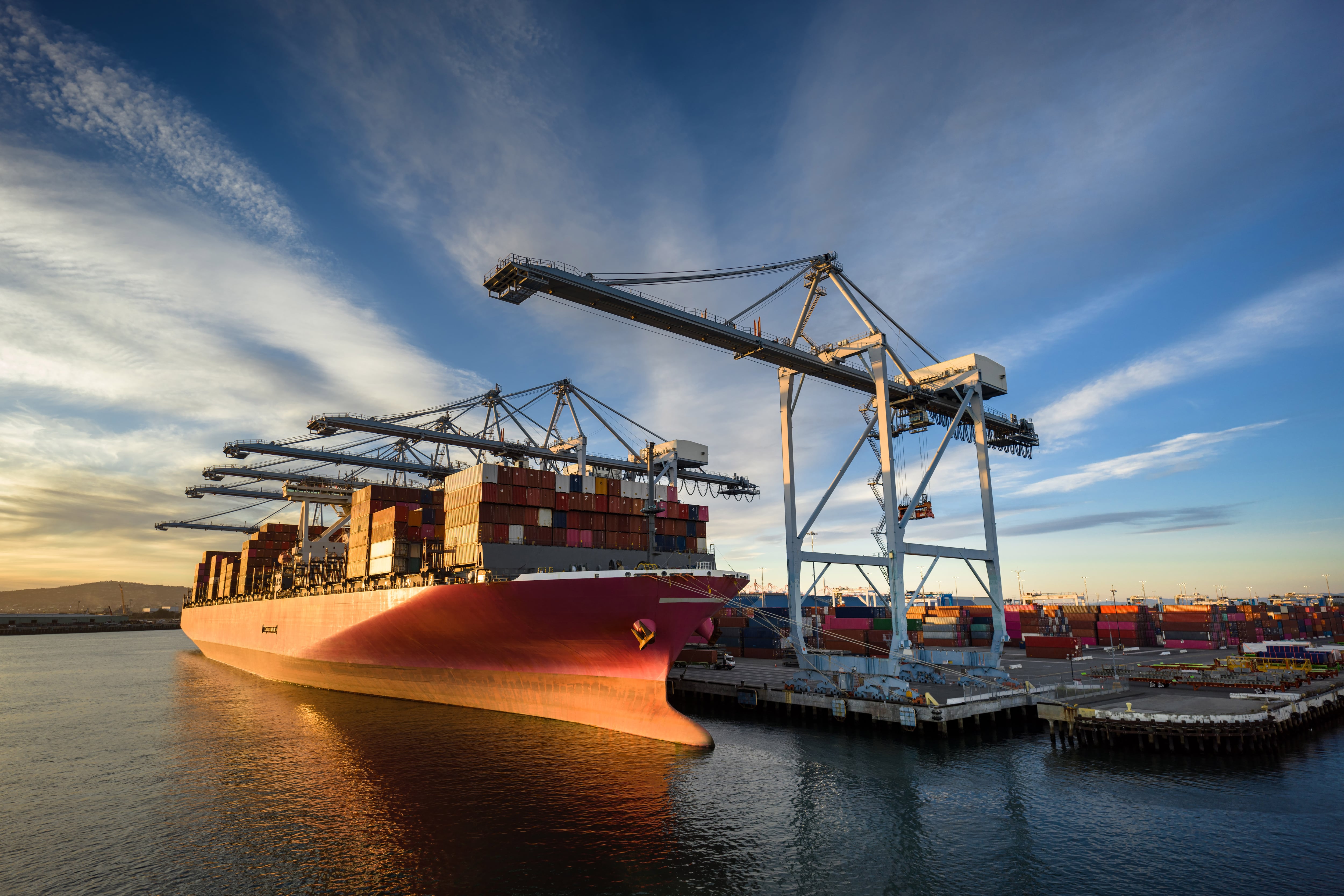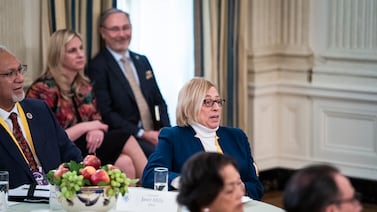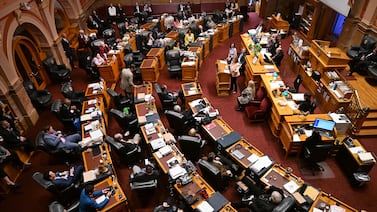Editor’s note: After this story published, President Donald Trump announced a 90-day pause on most tariffs but said tariffs on China would increase to 125% in retaliation for the China’s response to American tariffs.
Sign up for Chalkbeat’s free weekly newsletter to keep up with how education is changing across the U.S.
Faced with rising food costs and delivery fees approaching $400,000 a year, Lauren Weyand decided this spring that it was time for her North Carolina school district to invest in another walk-in freezer.
Storing more food on site would help Weyand save money over time, one piece of the complicated budget puzzle she’s constantly working on as the nutrition director for Craven County Schools.
But even the lowest bid gave her sticker shock. Two years ago, she paid $100,000 for a freezer of the same capacity. Now it would cost $160,000.
“‘I can promise you, if you wait till next school year, this isn’t going to get any better,‘” Weyand said the company representative told her. “I asked, ‘How much more?’ And he said, ‘You saw what they imposed. That cost is going to trickle down.’ ”
From heavy kitchen equipment like freezers and ovens to the gloves that cafeteria workers use, from laptops and tablets to pencils and paper, U.S. schools likely will feel the impact of sweeping tariffs going into effect this week.
Tariffs are a tax on imported goods. That tax is paid by the company bringing the product into the United States, and some or all of the cost is passed on to buyers.
President Donald Trump campaigned on imposing tariffs to bring in new revenue and boost American manufacturing, goals that many economists say are in conflict. But many business leaders expected Trump to use tariffs primarily as a negotiating tactic to extract concessions from other countries and ensure more favorable markets for American goods.
That looks increasingly unlikely, at least in the short term. Trump has said he is open to reversing tariffs in return for “phenomenal” offers but so far has turned down most attempts to negotiate. Meanwhile, China and the United States appear headed for a trade war.
A 10% across-the-board tariff on most imported goods went into effect April 5. Much higher tariffs, which the administration is calling reciprocal tariffs, take effect April 9 against a long list of countries. Trump set tariffs on China at 104%.
It’s hard to put firm numbers on the impact because there is significant uncertainty about how long tariffs will last and how high they’ll go. Some vendors will be able to shift production to American suppliers, while others will not, especially in the short term.
Schools could delay some purchases or construction projects rather than take on higher costs, but even repairing old equipment could get more expensive as many parts come from abroad.
“We’re still learning a lot, as this is a moving target,” said David Albert, chief communications officer for the New York State School Boards Association. “But schools are pretty large purchasers of many goods. They’re like mini cities.”
Tariffs increase economic uncertainty in already rocky times
American school districts already are dealing with budget hits from declining enrollment and the expiration of pandemic relief money, with many districts considering layoffs and school closures. Stocks have plummeted in response to fears that tariffs will tank the economy. Some economists predict the U.S. is headed for a recession, which also would affect state and local tax revenues.
One California superintendent said she’s worried about the market because capital gains taxes are an important source of state funding. If investors lose money, they don’t pay capital gains taxes.
Voters feeling their own economic pain may be more reluctant to approve levies and school bonds that would raise their property taxes.
Most school districts are working on their budgets now, Albert said, and would have to find cuts somewhere to absorb price increases later, assuming tariffs are still around in a few months. But if tariffs lead to a stronger manufacturing base and more good-paying jobs, Albert said, that would be good for school district budgets over time.
Equipment costs a growing concern for school nutrition directors
By law, most food served in school cafeterias must come from American sources, but there are exceptions for items that are difficult or too expensive to source domestically. Nearly all bananas, for example, come from five Latin American countries that now are subject to 10% tariffs.
Tariffs are landing after several years in which food prices have soared and federal reimbursements haven’t kept pace, said Diane Pratt-Heavner, a School Nutrition Association spokesperson. The Trump administration canceled a major grant program that helped schools buy from local farmers, and Republicans in Congress are debating further cuts to school meals programs.
Pratt-Heavner said school nutrition directors expect continued food cost increases related to inflation, but the real concern when it comes to tariffs is equipment costs. Many schools have outdated kitchen equipment that is increasingly expensive to repair, so they’re looking to buy new equipment, she said. Equipment might come from abroad or be assembled here using parts from abroad.
Schools are preparing to comply with new rules adopted under the Biden administration that require that meals have less sugar and salt. That means more scratch cooking, but even mixing bowls or gloves come from overseas, Pratt-Heavner said.
In North Carolina, Weyand said she keeps a detailed spreadsheet of the repair history of every piece of equipment across 25 schools. A one-man maintenance team fields “at least 10 emergencies” daily to keep equipment in working order for kitchens that serve 500 to 600 meals an hour every day.
Weyand wants to do more scratch cooking that makes better use of the USDA commodities her district receives. She sees that as key to controlling costs — but doing that requires investing in equipment whose prices keep going up.
“I look at my spreadsheet,” she said. “How much equipment do I have that I feel confident will give me another five years so that I could invest in more ingredients for scratch cooking? Do I need to spend more money on equipment? It’s a game of chess.”
School construction costs likely to increase
With the U.S. importing everything from steel to desks to lighting fixtures from China, tariffs are expected to have a big impact on construction costs.
Ken Simonson, chief economist for the Associated General Contractors of America, a trade association representing non-residential builders, said schools with projects already under contract shouldn’t be affected much because districts typically enter into fixed-price or maximum-price contracts.
But future projects could get more expensive.
U.S. steel mills have some capacity to increase production and that could offset some of the impact of tariffs on everything from structural steel beams to the studs that hold up wallboard, he said. But aluminum, which goes into window cladding, likely will continue to be imported. A lot of cement comes from Canada and Mexico. Copper tariffs, which would affect the cost of wiring, are still up in the air.
“Both the uncertainty and the certainty are making things more difficult,” Simonson said.
Laptops don’t live forever
Laptops and tablets became standard school supplies during the pandemic, and many districts continue to want every student to have a personal device. But many of the devices purchased with pandemic dollars are reaching the end of their lifespans and are in need of replacement.
Planning for those costs just got a lot harder.
“Because of the changes, even in the last couple weeks, it’s impossible to know what schools will have to pay for devices or even crayons or pencils,” said Sara Kloek, vice president for education and children’s policy with the Software Information Industry Association, a trade association that represents information industry companies, including many curriculum suppliers and educational technology companies.
Companies likely won’t pass on all their extra costs because they want to be good partners and know school district budgets are limited. But they also have to watch their own bottom lines.
Repair costs are likely to increase because so many parts come from abroad. And the reality of giving devices to kids is that they will need repairs.
“It’s unpredictable for schools if they don’t know if they’re going to have to pay 30% to 50% more on a charging cord that somebody lost when they moved apartments,” Kloek said.
One company encouraged school districts to shift more repair costs to parents.
Costs for learning games and materials for math and science lessons could also rise, Kloek said.
But more traditional learning materials might see the least price increase. Books are generally exempt from tariffs, and most books for the American market are printed in the United States.
The paper they’re printed on, however, comes from Canada and will still face tariffs.
Erica Meltzer is Chalkbeat’s national editor based in Colorado. Contact Erica at emeltzer@chalkbeat.org.







